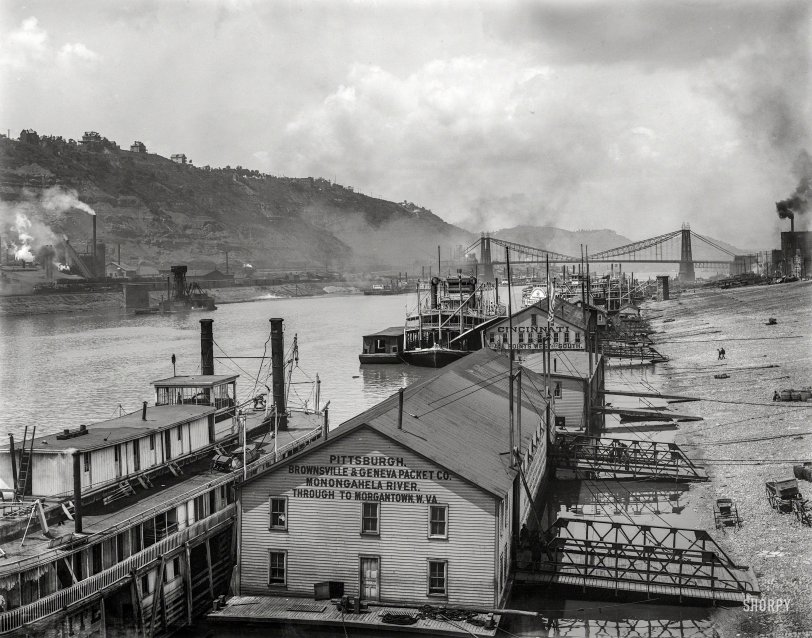


Framed or unframed, desk size to sofa size, printed by us in Arizona and Alabama since 2007. Explore now.
Shorpy is funded by you. Patreon contributors get an ad-free experience.
Learn more.

- Lofty addition
- In 1912
- Keenan Building
- Six years old
- Taken from the P.J. McArdle Roadway?
- It stood only 47 years
- Three track mind
- Incline to the right
- Reach for the sky, 1912 style
- No clean sweep
- Same Job Title, Same Face
- Sadly Lost
- Beautiful ...
- Where you get your kicks
- Aim High
- Pueblo Revival sisters
- Pueblo Neoclassicism
- Milk Man
- Regional dialect.
- Spielberg's inspiration
- Great Photo
- Loaf Story
- Do you still have the Rakes category?
- Could almost be a scene from the 1957 movie 'Hell Drivers'
- The Wages of Fear.
- Conspicuous by their absence
- Got Milk?
- All that aluminum
- No lefties
- Smoke 'em if you've got 'em
Print Emporium
Through to Morgantown: 1905

Circa 1905. "Pittsburgh, Penna. -- the Monongahela wharves." 8x10 inch dry plate glass negative, Detroit Photographic Company. View full size.
Bridge abutments
They are probably the beginnings of the Wabash (Railroad) Bridge built between 1902 & 1904, possibly fitting the "Circa 1905" caption.
There's a lot of long lens compression in this photo, but everything seems to fit with a vantage point somewhere near the current Smithfield Street Bridge, looking northwest toward the second Point Bridge (1877-1927 trussed eyebar/"suspension"), with the Duquesne Incline visible just beyond the left end. The current Fort Pitt Bridge wouldn't obstruct this view until ~1959.
If so, the more robust final versions of the Wabash Bridge piers still survive its 1948 demolition: https://en.wikipedia.org/wiki/Wabash_Bridge_%28Pittsburgh%29#/media/File...
Yes they float.
Typically called wharfboats, the offices of steamer lines would be built on barges or older steamboat hulls. They would rise and fall with the river on poles driven into the riverbed. Anchor lines to the levee would provide additional security.
A bridge too far
There seems to be bridge abutments on either side of the river. Could it be there was a bridge planned but never constructed?
Floating wharf buildings?
Curious if those large structures were "floating" so as to rise and fall with river levels (spring flooding, ice flows, heavy rains)? I can't see them hard piered to the river bottoms as they are pretty close to the water line.
The Rose Hite
The Rose Hite may have been a bit of a hard-luck boat. She was recorded as being involved in a collision on the Evansville district of the Ohio River in 1896 (no information on damage to either boat). She collided with the towboat John F. Kuen (or Joe P. Klein; newspaper accounts differ) in 1905 on the Monongahela near Brownsville, PA, and sank with the loss of either four or five crew reported drowned. She was raised and continued to operate on the Monongahela river system until 1907, then was sold in 1908, renamed the Gracey Childers, and moved to the Cumberland River. She burned in September 1909 at Paducah, Kentucky.
At the wharfboat.
In the lower left is the Rose Hite (second boat with that name) built in 1895 at the Howard yard in Jeffersonville, Indiana. A bit of a mystery, according to Way's Packet Directory -- the pilot house was moved forward of the Texas deck after the boat was renamed Gracie Childers in 1908. The boat facing us is the Queen City, built at Cincinnati in 1897. A very posh boat with top finishes and fittings, it catered to Pittsburgh's finer citizens. Her hinged stacks are laid down to run low bridges.
























On Shorpy:
Today’s Top 5